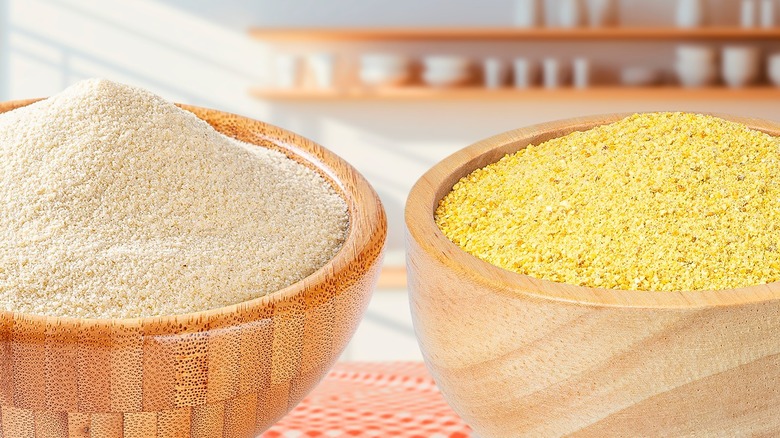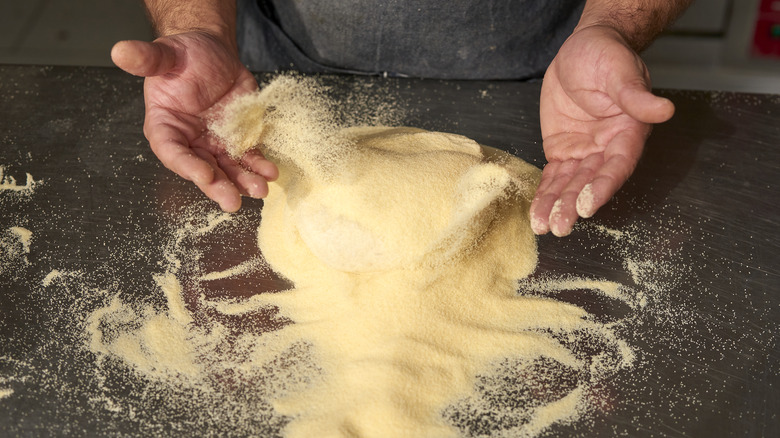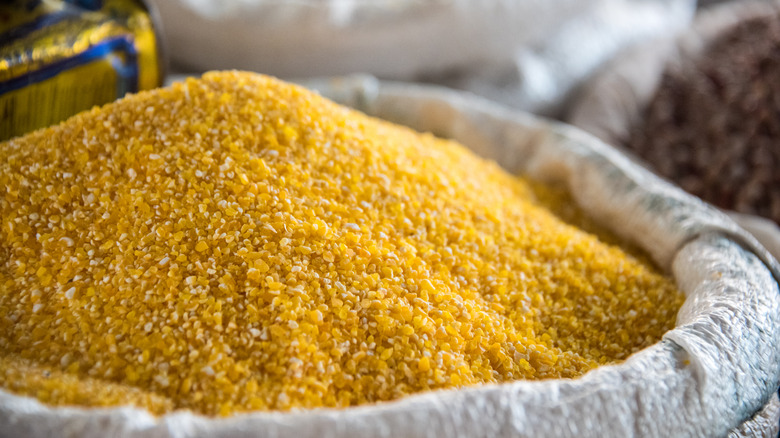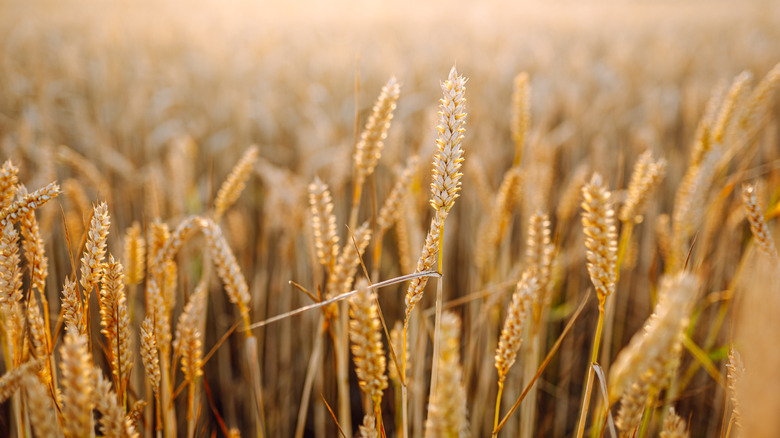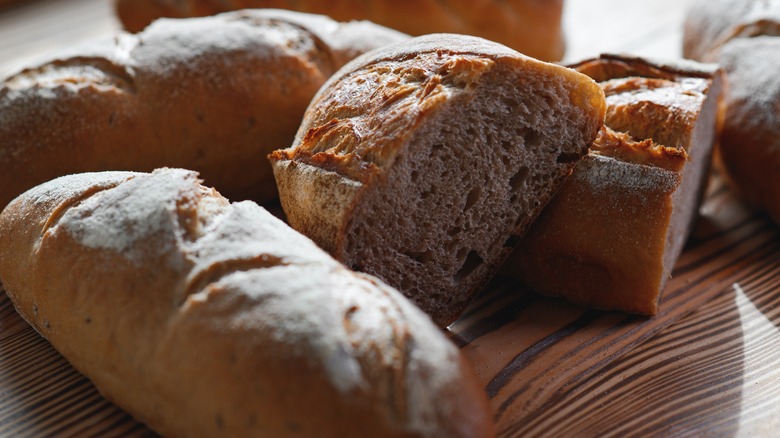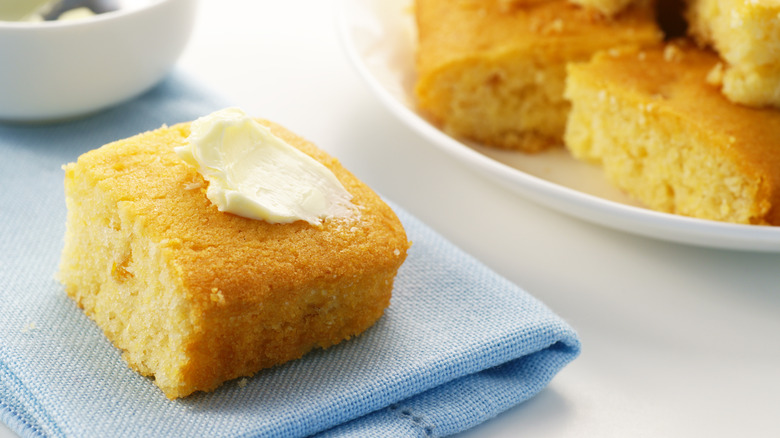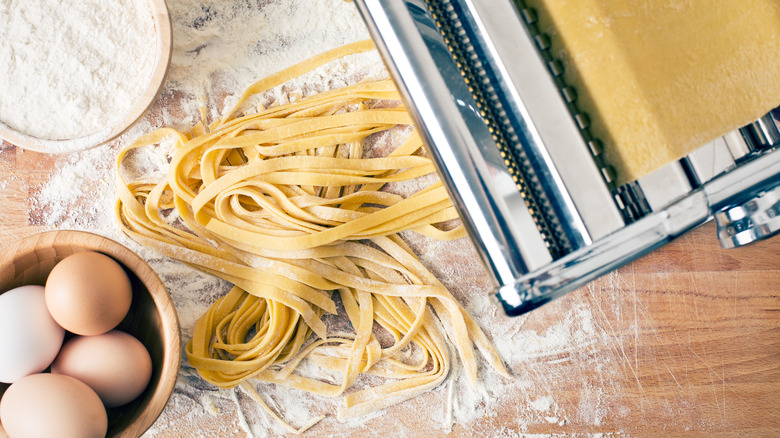Semolina Flour Vs Cornmeal: Is There A Difference?
Semolina flour and cornmeal are often listed as interchangeable when you want to add a little crunch to something baked or to make a pizza stop sticking to the pan, but don't let those uses convince you that there aren't a lot of differences between the two. In the ever-expanding world of alternative and artisan flours and grains, it's not so easy to be sure of what you're getting anymore. Gone are the days of white flour or whole wheat, with bread flour, pizza flour, nut flours, and ancient grains filling the shelves. So you're left standing with your phone, searching to find out if this flour is gluten-free or what arrowroot even is. And when recipes tell you semolina or cornmeal will both do, it's easy to just throw your hands up and figure the differences don't amount to much.
Most people know cornmeal, it's a classic and its clearly corn — blissfully simple for the most part. It is semolina that is tricker for most people to grasp. Visually, it can appear similar to cornmeal, be it more fine in texture, yet unlike so many things called "flour" these days, it is actually made from wheat. Semolina flour has been used for a long time — it's particularly popular in Italy but, outside of some niche uses, it's only gotten popular in the U.S. more recently. And while semolina and cornmeal can sometimes be swapped for each other, there are lots of recipes where only one would work.
What is semolina flour?
Semolina is a wheat flour that is made from a specific strain called durum wheat. Durum wheat is one of the oldest types of wheat cultivated in the world. It's grown primarily in the Middle East and originated between 10,000 and 12,000 years ago, being domesticated from one of the original wild forms of wheat that grew in the Eastern Mediterranean. Compared to most commercially grown wheat, durum (and thus semolina) is a "hard" wheat, meaning it has a naturally higher protein content and forms more gluten. Durum makes up between 5%-8% of worldwide wheat cultivation, making it one of the most popular types, but its unique flavor and texture give it a number of specialty uses.
Semolina is used for bread, cakes, and other types of baking, but it is especially popular for making store-bought pasta because the flour's high protein and strong gluten bonds help pasta hold its shape better. In fact, semolina's golden color compared to normal wheat is why most pasta is yellow. Semolina is also used to make couscous or combined with liquid to make different forms of porridge. While semolina can come in different textures, most store-bought versions are medium grind, which is coarser than most other wheat flours. Semolina's texture is what contributes to the confusion with cornmeal, as semolina is sometimes used as a general term for any coarsely ground grain, like corn or other types of flour.
What is cornmeal?
Cornmeal is a versatile starch made from coarsely ground field corn. Cornmeal can come in any color corn does, like white or blue, and also a variety of different grinds, but the most common is medium-ground yellow cornmeal made from dent corn. While yellow cornmeal is sweeter than the other colors, dent corn isn't your normal corn-on-the-cob sweet corn. Dent corn is less sweet than corn that you would eat fresh and has more starch and a harder texture. However dent corn is still the most widely grown corn in the U.S. because it has tons of other culinary uses. Besides being ground into cornmeal, dent corn gets turned into chips and corn flakes, pressed for corn oil and high fructose corn syrup, and is fed to livestock.
Cornmeal has tons of uses and also plenty of variations that aren't actually labeled cornmeal. Polenta and grits are both types of cornmeal that get turned into porridge. Boxed cornbread mixes are part cornmeal but also includes other additives like sugar and baking soda. Cornmeal is also very similar to corn flour and cornstarch, but the latter two are more finely ground in a way that gives them different culinary uses. More so than semolina flour, cornmeal is defined by its texture compared to other ground corn products.
Semolina flour is made from wheat
Despite its coarse, corn-like appearance, semolina flour is still wheat flour, which means it's much closer to your traditional white and whole grain flours than it is to corn. Culinarily, the biggest way this manifests would be that semolina flour has gluten, which is suitable for all kinds of baking that cornmeal isn't. Semolina can be substituted for flour in all sorts of bread recipes and, because of its high protein content, can actually improve the gluten structure of your loaf. There are also traditional breads like pane Siciliano that are made from semolina. Cakes, pancakes, and any other baked good that need gluten's ability to trap air can all make great use of semolina as well.
As it's made from corn, cornmeal is naturally gluten-free and, thus, won't make an effective flour substitute in most recipes. Cornmeal can be added to batters as a flavoring or texture agent and can make quick breads and cakes with a rising agent like baking powder, but the lack of gluten results in a dense structure in most baked goods. However, if you don't have grits or polenta on hand, cornmeal can achieve a similar result to those products. One thing to note is that because semolina is made from one type of flour but cornmeal can be made from a variety of corn, there is more variance in the flavor of cornmeal.
Both grains have a similar nutritional profile
Semolina flour and cornmeal may have different origins, but one area where they are surprisingly similar is in their nutritional profiles. The one obvious exception is for those with issues eating gluten or Celiac, who should avoid semolina — but beyond that, they offer many of the same benefits at the same levels. Going on the basis of one cup of grain for semolina and cornmeal, both products have the same level of carbohydrates, coming in at 44%-45% of your daily recommended values. They also have almost the exact same amount of dietary fiber, with semolina having incrementally more at 6.5 grams compared to 6.1. Both also have modest but meaningful amounts of iron and potassium. And fat isn't something to worry about — even though cornmeal has fractionally more fat, neither are meaningful sources.
One area where semolina is more nutritious is protein. Cornmeal has a solid amount of your daily protein at 22%, but semolina has almost double that. Semolina also has about 50% more phosphorus than cornmeal. And finally, semolina is free of sugar, added or otherwise, while corn is a small source of natural sugars.
Cornmeal has a sweeter flavor
While cornmeal is not as sweet as typical fresh corn, it still imparts sweetness to recipes and tastes very clearly of corn. Cornmeal crusted fried fish and meat will get plenty of that sugary, starchy summer taste in every bite, and it adds its own milky sweetness to baked goods. There really is no mistaking it and, if anything, the taste of cornmeal can be a little overpowering if you add too much of it as a substitution. But for corn lovers, it's a great way to add tons of taste with just one ingredient.
Semolina has a unique flavor profile that differs from a lot of other flours. It has a stronger flavor than white flour and shares the nuttiness of whole grain flours, but it also has distinct earthy notes. Despite being lower in sugar than cornmeal, it does add a little more sweetness than most flours, which means it sometimes has a similar effect as cornmeal on baked goods. In fact, if you taste a semolina bread, you'd be forgiven for guessing there was cornmeal in it, but semolina has a more subtle, complex taste.
Both semolina and cornmeal are coarse grains with lots of baking uses
While there are plenty of recipes where cornmeal and semolina won't be proper replacements for each other, they are united in being extremely versatile coarse grains. One of the reasons you see them recommended for similar roles in bread and pizza is their texture. Cornmeal and semolina flour not only adds crunch when sprinkled on the exterior of baked goods but also help keep doughs from sticking to surfaces, making them easier to slide onto baking peels and into ovens and easier to grab without having the dough cling to your hands.
If you are someone who likes making fresh pasta at home, semolina is something you should have on hand to give your dough a more robust flavor. You can try substituting semolina in your favorite bread recipes for a better crumb and structure and to get a taste of semolina's unique flavor, but don't sleep on it for desserts either. Semolina's natural light sweetness and nuttiness really shine in recipes like a simple Middle Eastern Semolina cake. You probably don't need anyone telling you to make cornbread, but cornmeal's potential goes so much farther than that. It's a delicious way to make fluffy blueberry pancakes, can be made into cornbread stuffing for casseroles and roasts, or used to thicken stews and sauces while imparting its signature sweet corn flavor.
